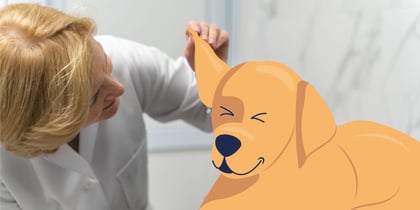Yeast Infection in Dogs: Everything You Need to Know

Yeast infections are extremely common and affect a dog’s skin or ears, making them sore, irritated, and itchy. A yeast infection can often indicate an underlying health problem that needs addressing.
Malassezia pachydermatis lives naturally on the skin causing no harm to your pet – it’s known as a ‘commensal’ organism. But yeasts can bud and spore, causing them to increase in numbers; this is when a yeast infection occurs. Bacterial infections can also occur in the skin and ears, so it’s important for the vet to establish the type of infection in order to treat it appropriately.
What Causes Yeast Infections in Dogs?
A yeast infection can occur for a number of reasons and is often a symptom of an underlying problem. Yeasts love warm, moist environments which means that ears are a perfect place for them to grow. The ear canal goes downwards and then along towards the head in an ‘L’ shape, so debris and wax collect easily here. Some dogs have naturally very narrow ear canals, very hairy ears, or long floppy ears - these dogs are particularly prone to ear infections. Similarly, dogs with skin folds can get yeast overgrowths as again this is a perfect environment for yeast to thrive.
Dogs suffering from allergic skin diseases are especially susceptible to yeast infections. When allergens such as pollens, mites, food ingredients, molds, or dust trigger a reaction, the skin becomes irritated and itchy. Once the skin becomes sore and damaged, it triggers a secondary yeast or bacterial infection. Uncontrolled allergic skin disease is one of the most common causes of yeast infections in dogs.
Regular bathing or regular swimming can also cause yeast infections. If the ear is not kept dry, debris and water become trapped in the ear canal providing yeast with the perfect environment to overgrow. Not grooming long thick coated breeds regularly enough can also cause yeast infections of the skin, as the dense dead undercoat allows the skin to become warm and moist.
Some other common causes of yeast infections are:
-
A foreign object in the ear
-
Poor hygiene
-
Hot/humid weather or seasonal allergies
-
Use of products that alter the natural environment of the skin/ears
-
A ruptured eardrum
-
A polyp or tumor in the ear canal
What are Yeast Infection Symptoms in Dogs?
Yeast infections are easy to spot, so as soon as you notice something is not right with your dog’s skin or ears, it’s important to get them checked by your veterinarian. If left too long, yeast infections can require much longer courses of treatment and cause significant discomfort to your pet.
The most common places to find yeast infections are in the ears, paws, groin, armpits, and skin folds.
Signs of yeast infections include:
-
Itching, scratching and rubbing
-
Head shaking or a head tilt
-
Excessive dark discharge from the ears
-
Crying or yelping when scratching their ears
-
Excessive licking
-
Red, warm, and inflamed skin
-
Dark or thickened skin with a leathery feel indicates a chronic problem
-
Scaly or crusty skin
-
Greasy skin
-
A distinctive odor
-
Hair loss
How Can Yeast Infections be Diagnosed in Dogs?
Fortunately, it’s easy to diagnose yeast infections. The vet will thoroughly check your dog’s skin over their whole body looking for any changes and look down their ear using an otoscope.
Samples of the affected area of your dog’s skin can be taken such as hair plucks, skin scrapes, or swabbing their ear canal, and then analyzed under a microscope to look for yeasts. It’s common to also find bacteria on your dog’s skin. Once diagnosed, yeast infections and ear infections are easy to treat.
How Can Yeast Infections be Treated?
Yeast infections are usually easy to treat and need to be managed alongside any underlying allergies or problems.
Potential treatment for yeast infections and underlying causes include:
-
Topical treatment – antifungal creams and antifungal ear drops are the most common treatment
-
Oral medication – more severe or chronic yeast infections need long courses of oral medication
-
Anti-inflammatory medication – these reduce skin inflammation and help your dog feel more comfortable
-
Medicated baths – a medicated shampoo to use once or twice a week can help prevent yeast overgrowing on your dog’s skin, soothe the skin, and keep the skin healthy
-
Ear cleaners – it's important to keep ears clean and free of wax/debris. Using an appropriate ear cleaner every so often, or before starting a course of topical antifungals, can help treat and prevent infections
-
Anti-allergy medication – if your dog has underlying allergies, the vet will recommend you start on long-term treatment. There are several options available that you can discuss with your vet including tablets and injections
-
Hypoallergenic diet – these prescription diets will prevent flare-ups if your dog has food allergies
Frequently Asked Questions
Are yeast infections painful?
Yeast infections can be painful if they become chronic. Usually, yeast infections are very itchy and uncomfortable.
How can I prevent my dog from getting a yeast infection?
Keeping your dog’s feet clean and dry, regular grooming, preventing them from swimming, and regular ear cleaning can prevent yeast infections. Controlling underlying allergies will prevent secondary infections.
Are some breeds more susceptible to yeast infections?
Breeds with skin folds and long hairy ears are prone to yeast infections, such as Pugs, Shar Pei’s, Bulldogs, Spaniels, Poodles, and Basset Hounds. Several other breeds including Schnauzers, Westies, Shih Tzus, and Maltese may also be prone to yeast infections.
Summary
Yeast infections can be a bothersome issue for dogs, but with proper knowledge and care, you can help your furry companion overcome this condition. It's important to recognize the signs and symptoms of yeast infections, such as itching, redness, and odor, and seek veterinary guidance for an accurate diagnosis and effective treatment.
Maintaining your dog's skin health is crucial in preventing and managing yeast infections. Regular check-ups and dermatologic examinations by a qualified veterinarian can play a vital role in identifying any underlying skin issues early on. If you're concerned about your dog's skin health or suspect a yeast infection, consider scheduling an appointment with a trusted veterinarian.






